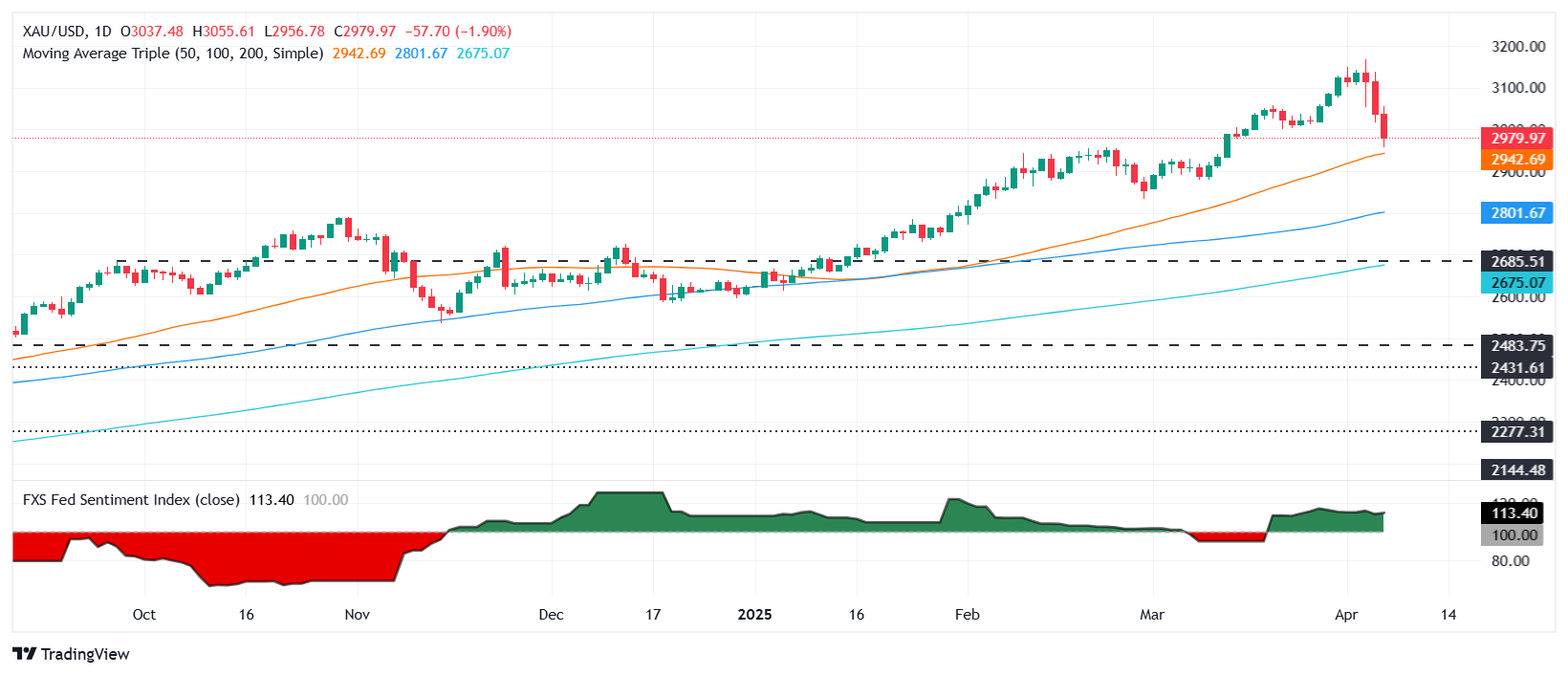- Gold reaches mid-March low amid US-China trade war escalation and global risk-off sentiment.
- Trump refutes 90-day tariff pause rumors, propelling DXY to 103.29 and 10-year yields to 4.15%.
- Investors await FOMC minutes, CPI, and PPI; inflation outlook and rate cut bets grow uncertain.
Gold (XAU) price prolongs its agony and plummets by over 2% on Monday as investors seeking safety bid the US Dollar, with US trade policy fueling speculation of a global recession. XAU/USD trades at $2,971, its lowest level since mid-March, below $3,000.
The King Dollar is back after reaching a six-month low last week, after US President Donald Trump revealed reciprocal tariffs on Wednesday. Last Friday, China retaliated by imposing a 34% duty on all imports from the US, sparking turmoil in the financial markets as most global equity indices posted losses.
Earlier, the White House advisor Hassett announced that the government might approve a 90-day pause in tariffs, though it would depend on Trump. Nevertheless, the Trump administration rejected that statement, which was later revealed as “fake news,” according to CNBC.
Bullion prices were also undermined by the rise in US Treasury yields, with the 10-year note coupon increasing by almost fifteen basis points to 4.147%. In the meantime, the US Dollar Index (DXY), which tracks the performance of the USD against a basket of six currencies, climbs 0.39% to 103.29.
Ahead this week, the US economic docket will feature the release of the Federal Open Market Committee (FOMC) meeting minutes on Wednesday, followed by the announcement of the consumer and producer inflation data.
Daily digest market movers: Gold price tanks as the US Dollar counterattacks
- US real yields edge surge 14 bps to 1.967%, according to US 10-year Treasury Inflation-Protected Securities (TIPS) yields.
- The US Consumer Price Index (CPI) is expected to fall from 2.8% to 2.6% YoY in March. The Core CPI is projected to decline over the next twelve months, from 3.1% to 3%.
- Recently, Fed Governor Adriana Kugler said that tariffs and shortages are important to consider when forecasting inflation. She added that new tariffs will be “consequential” and have already begun to see some price increases.
- Recession fears ignited as depicted by the US10s to 3 months yield curve inversion, with the latter paying 27 bps more than the US 10-year yield.
XAU/USD technical outlook: Gold price plummets below $3,000 a troy ounce
Gold is puking at the time of writing, as sellers continue to push prices lower, beneath the $3,000 mark. The Relative Strength Index (RSI) fell sharply, turning bearish, hinting that the golden metal could consolidate around the 50-day Simple Moving Average (SMA) of $2,942 – $3000. A breach below the former could push prices toward the $2,900 mark, followed by the 100-day SMA at $2,801.
Conversely, if buyers push Gold back above $3,000, look for a test of the $3,050 figure.

Gold FAQs
Gold has played a key role in human’s history as it has been widely used as a store of value and medium of exchange. Currently, apart from its shine and usage for jewelry, the precious metal is widely seen as a safe-haven asset, meaning that it is considered a good investment during turbulent times. Gold is also widely seen as a hedge against inflation and against depreciating currencies as it doesn’t rely on any specific issuer or government.
Central banks are the biggest Gold holders. In their aim to support their currencies in turbulent times, central banks tend to diversify their reserves and buy Gold to improve the perceived strength of the economy and the currency. High Gold reserves can be a source of trust for a country’s solvency. Central banks added 1,136 tonnes of Gold worth around $70 billion to their reserves in 2022, according to data from the World Gold Council. This is the highest yearly purchase since records began. Central banks from emerging economies such as China, India and Turkey are quickly increasing their Gold reserves.
Gold has an inverse correlation with the US Dollar and US Treasuries, which are both major reserve and safe-haven assets. When the Dollar depreciates, Gold tends to rise, enabling investors and central banks to diversify their assets in turbulent times. Gold is also inversely correlated with risk assets. A rally in the stock market tends to weaken Gold price, while sell-offs in riskier markets tend to favor the precious metal.
The price can move due to a wide range of factors. Geopolitical instability or fears of a deep recession can quickly make Gold price escalate due to its safe-haven status. As a yield-less asset, Gold tends to rise with lower interest rates, while higher cost of money usually weighs down on the yellow metal. Still, most moves depend on how the US Dollar (USD) behaves as the asset is priced in dollars (XAU/USD). A strong Dollar tends to keep the price of Gold controlled, whereas a weaker Dollar is likely to push Gold prices up.

